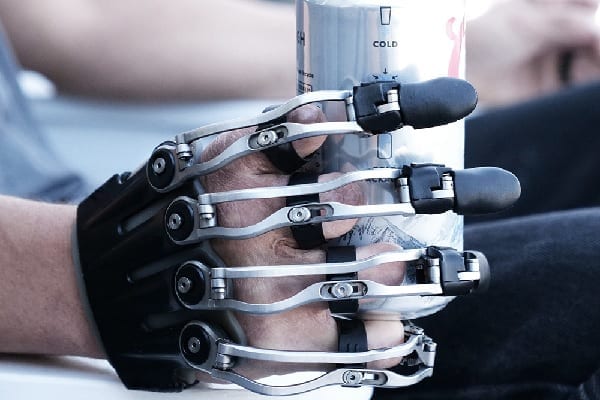We don’t normally cover non-bionic devices, but with a lack of affordable bionic options for partial-hand amputees, we’re making an exception.
The Different Types of Mechanical Partial-Hand Devices
Body-Powered
A body-powered partial-hand prosthesis is basically a mechanical extension of the residual natural hand.

Its ultimate objective is the same as that of its bionic counterpart, i.e. to allow users to grasp and hold objects. But it achieves this using strictly mechanical means powered by flexing the residual hand’s remaining muscles.
The degree to which this is possible, including the amount of force generated, depends in large part on the remaining bones and muscles. This can be greatly amplified through the ingenious use of leverage, but if there is insufficient residual hand structure, this may not be the right solution.
Ratcheting Mechanical Partial-Hand Prostheses
A ratcheting mechanical hand prosthesis does not require direct muscle control because it does not actively grasp objects. Instead, the user bends the mechanical digits around an object using his or her other hand. A finely tuned ratcheting mechanism locks the fingers in place, resulting in a firm grip.
This short video from Point Designs perfectly demonstrates this mechanism:
We’ll show this device in action shortly.
Current Manufacturers
There are three main manufacturers currently in this field:
- Naked Prosthetics makes mostly body-powered devices, though it does have one ratcheting device
- Point Designs makes ratcheting devices
- Partial Hand Solutions LLC makes body-powered and ratcheting devices
We provide a brief description of each below.
Naked Prosthetics
Naked Prosthetics has mastered the use of body-powered devices for partial-hand amputees, which the following video clearly demonstrates:
These types of devices are so useful that they can make a huge difference in the life of a partial-hand amputee:
Although these devices are strictly mechanical, it doesn’t mean that they can’t interact with modern technology:
Visit Naked Prosthetics for more information.
Point Designs
Just as Naked Prosthetics has mastered body-powered solutions, Point Designs has mastered ratcheting solutions.
We’ve shown you how the ratcheting mechanism works for an individual finger. Here’s an entire device:
When we first saw this type of device (i.e. before we fully understood it), we wondered if it would be strong enough for some tasks. Videos like this quickly answered that question:
And here’s a video showing the wide variety of tasks that a ratcheting device can perform:
But here’s our favorite video and the reason that we devote thousands of volunteer hours a year to helping those with limb differences to understand their technology options:
That’s just awesome!
Visit Point Designs for more information.
Partial Hand Solutions LLC
Those who follow our website know that we never play favorites between prosthetic manufacturers. We don’t accept money in any form from the prosthetic industry, so we don’t care who wins the marketing war. We just want to see the world eliminate the disability aspects of having a limb difference.
That having been said, there are times when we have to criticize certain manufacturers for what we view as rather obvious oversights.
Partial Hand Solutions LLC is one of those manufacturers. They seem to have a great lineup of partial-hand devices, both body-powered and ratcheting, but they appear to do a very poor job of marketing these solutions to the general public, as we can’t find any good recent videos of them.
As a result, all we can do is send you to their product page.
How to Choose Between the Different Partial-Hand Prosthesis Options
The most important step to choosing the right partial-hand prosthesis is to find a prosthetist who is intimately familiar with the available technologies. Partial-hand solutions are complex. Working out the best solution for your situation and objectives requires a great deal of experience.
That aside, here are some general points to keep in mind:
- Bionic solutions are appealing because they are more intuitive and augment your hand strength with electrical power, but they’re also fragile. Bionic fingers don’t stand up well to repeated heavy loads or challenging conditions involving water, a lot of dust, etc. If you face these challenges, you’ll at the very least need two solutions: a bionic prosthesis for light duties and something else for heavier duties.
- If you opt for a non-bionic solution, the shape and condition of your residual hand will likely dictate whether you need a body-powered versus a ratcheting device.
Related Information
For a list of all partial-hand options, including bionic options, see All Partial Hand Options.
For a comprehensive description of all current upper-limb technologies, devices, and research, see our complete guide.
